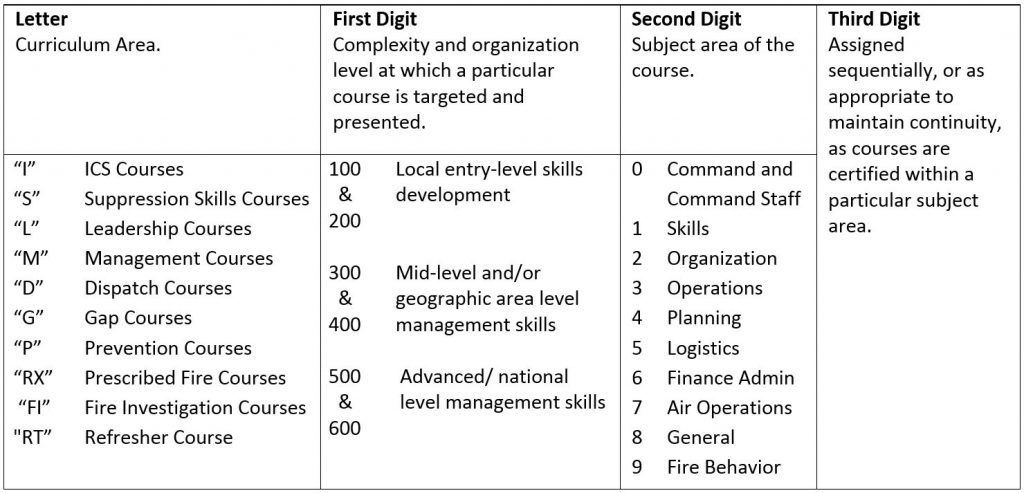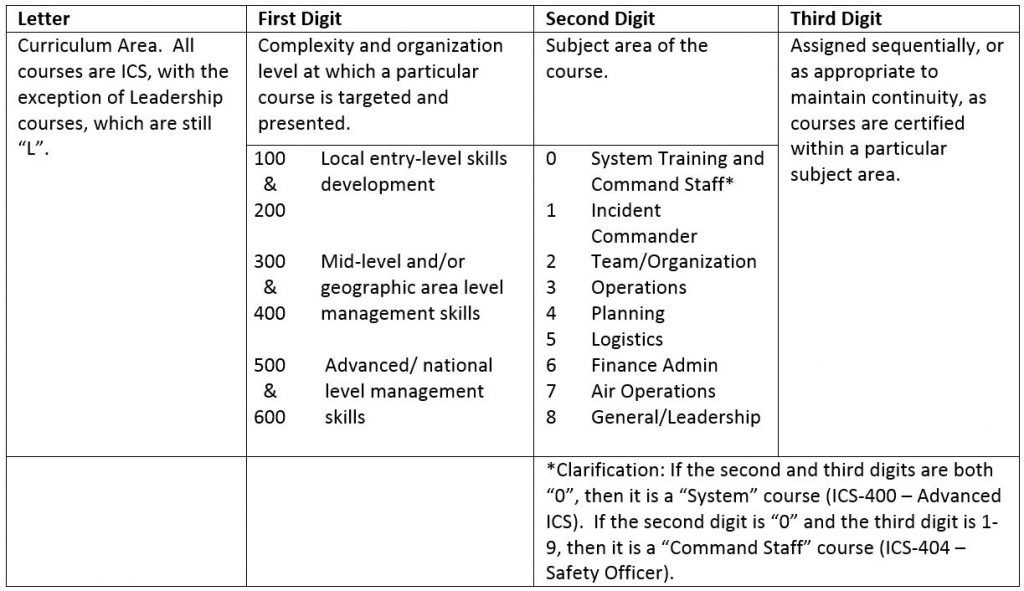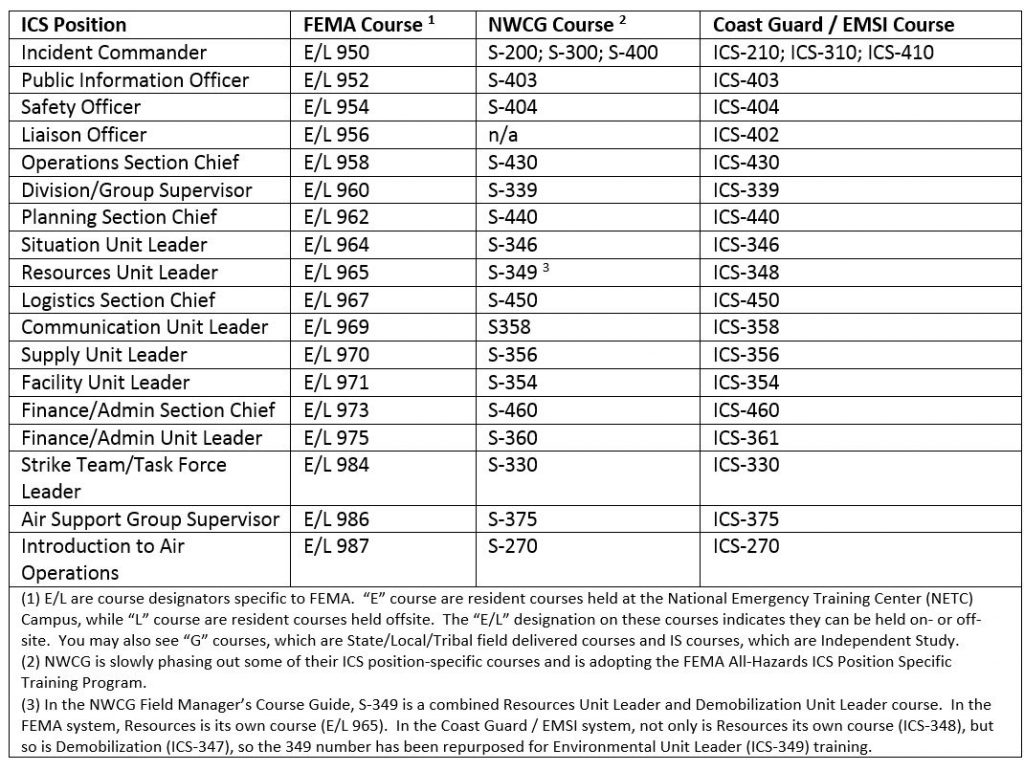Instructors speak in a numeric code when talking about ICS training, throwing around numbers like 300, 430, 346, 520, etc. Where do these numbers come from and what do they represent? There is a rich and relatively unknown history and explanation behind ICS course numbers and in this article, we will attempt to explain the method to the numeric madness. Even though there are numbers, it is not complicated and you won’t need a calculator!
Long before the release of the National Incident Management System (NIMS) in 2004 and the FEMA All-Hazards ICS Position Specific Training Program, ICS training has existed in the wildland fire community where there was, and still is, an extensive catalog of course offerings. The National Wildfire Coordinating Group (NWCG) long ago established an alpha-numeric numbering system. Under this system, courses consist of four characters, beginning with a letter and ending with three numbers (X-###). Each alpha-numeric combination designates a meaning unique to a specific curriculum, similar to a college course catalog. The NWCG numbering and lettering methodology is a complex, yet systematic, approach to course management. Once one understands the formula behind these letters and numbers, they can speak entirely in the jargon.
Breaking Down the NWCG Formula  How Does this all Work
How Does this all Work
We’ll begin with the simplified “I” curriculum, of which there are only five courses:
- I-100: Introduction to ICS
- I-200: Basic ICS – ICS for Single Resources and Initial Action Incidents
- I-300: Intermediate ICS – ICS for Supervisors and Expanding Incidents
- I-400: Advanced ICS – ICS for Command and General Staff and Complex Incidents
- I-402: ICS Overview for Executives/Senior Officials
In this example, you need only focus on the first numerical digit to understand that the course increases in complexity as the numbers increase.
Second, we’ll examine General Staff training in the “S” curriculum, of which there are only four courses:
- S-430: Operations Section Chief
- S-440: Planning Section Chief
- S-450: Logistics Section Chief
- S-460: Finance/Administration Section Chief
As you can see, the second numerical digit changes according to the functional area of the course, while the first digit (indicative of complexity) remains the same as it relates to General Staff training.
Third, we’ll examine Planning Section training in the “S” curriculum.
- S-244: Field Observer
- S-245: Display Processor
- S-346: Situation Unit Leader
- S-440: Planning Section Chief
As you can see, the first numerical digit changes as the position increases in complexity from staff to Unit Leader to General Staff, but the second digit (4) remains the same indicating that it is in the Planning Section subject area.
U.S. Coast Guard and EMSI ICS Course Numbering Methodology
In the early 2000s, with assistance from EMSI, the U.S. Coast Guard began to establish their own All-Hazards ICS training catalog prior to the roll out of the FEMA All-Hazards ICS Position Specific Training Program. Eventually, the Coast Guard and EMSI adopted the same ICS course numbering formula.
Under this system, all ICS courses, whether they were system courses (“I” courses under NWCG), position courses (“S” courses under NWCG), or team/organization courses (also “S” courses under NWCG), had the initial NWCG letter (“I” or “S”), replaced with “ICS”. Aside from that, the numbering system remained the same, with one exception: To avoid confusion between “I” courses, that were consistently numbered such as 100, 200, 300, and 400, and “S” curriculum courses for various Incident Commander positions that held the same number (200, 300, and 400), the second digit for the Incident Commander courses was switched from “0” to “1”. This worked in the new Coast Guard / EMSI system since the NWCG “Skills” curriculum area was irrelevant in the new “All-Hazards” model.
 This alleviated the confusion between courses like:
This alleviated the confusion between courses like:
 Today, the Coast Guard / EMSI system uses the following formula, derived from the NWCG formula.
Today, the Coast Guard / EMSI system uses the following formula, derived from the NWCG formula.
 FEMA All-Hazards ICS Position Specific Training Program
FEMA All-Hazards ICS Position Specific Training Program
With the release of NIMS in 2004, FEMA began to develop a nation-wide all-hazards ICS training program. The only remaining connection in course numbering to the original NWCG alpha-numeric numbering system remains at the system level, where I-100, I-200, I-300, and I-400 still retain their numbers as ICS-100, ICS-200, ICS-300, and ICS-400. Since ICS-100 and ICS-200 are available in a web-based, independent study format and are available as online training through FEMA’s Emergency Management Institute (EMI), those courses are listed on the EMI website as IS-100 and IS-200. In the FEMA/EMI system, the “IS” stands for “Independent Study” and is not a new variation of “Incident Command System”.
Course numbering for position training in the FEMA All-Hazards ICS Position Specific Training Program has gone a different direction and does not appear to follow as intricate a formula as the original NWCG alpha-numeric numbering system. Simply put, the new FEMA All-Hazards ICS Position Specific Training courses were assigned numbers in the already developed and expansive FEMA course catalog.
 A point of confusion still exists with ICS-402. In the FEMA and NWCG model, ICS-402 is ICS for Executives, a “System” level course that provides an overview of ICS for executive level personnel and clarifies the role of an agency or company executive in the system. In the Coast Guard / EMSI model, before the release of the FEMA ICS-402 ICS for Executives course, ICS-402 was already designated for the Liaison Officer position, which is why EMSI refers to the FEMA ICS-402 course simply by its common name, ICS for Executives, and not ICS-402.
A point of confusion still exists with ICS-402. In the FEMA and NWCG model, ICS-402 is ICS for Executives, a “System” level course that provides an overview of ICS for executive level personnel and clarifies the role of an agency or company executive in the system. In the Coast Guard / EMSI model, before the release of the FEMA ICS-402 ICS for Executives course, ICS-402 was already designated for the Liaison Officer position, which is why EMSI refers to the FEMA ICS-402 course simply by its common name, ICS for Executives, and not ICS-402.
Job Aids
There are certain positions that NWCG decided a training course is not necessary and instead developed a job aid. Job aids numbering follows the same NWCG formula:
- J-236 – Staging Area Manager
- J-342 – Documentation Unit Leader
EMSI took this a step further and has developed a job aid for nearly every position in the ICS organization. The job aids are incorporated into EMSI ICS position-specific training and serve as great references when filling the actual position on a response.
Summary
So that is the long and complicated history of ICS course numbering. As NWCG migrates to the FEMA All-Hazards ICS Position Specific Training Program for select ICS position training courses, some of this rich ICS course numbering history may be lost.
For questions about ICS course numbering and the EMSI All-Hazards ICS curriculum, do not hesitate to contact us.


